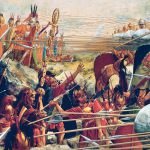First mention art of baking cheesecake appears in the work of the Greek philosopher Aegimus from the 5th century BCE. Apparently, the cake was eaten by the Olympians.
Cheesecakes were also known in ancient Rome as libium. It was a cheesecake associated with religious rituals. Cato the Elder in the work “De Re Rustica” included a recipe for it:
Bray 2 pounds (0,6549 kg) of cheese thoroughly in a mortar; when it is thoroughly macerated, add 1 pound (327,45 g) of wheat flour, or, if you wish the cake to be more dainty, ½ pound (163,725 g) of fine flour, and mix thoroughly with the cheese. Add 1 egg, and work the whole well. Pat out a loaf, place on leaves, and bake slowly on a warm hearth under a crock.
– Cato the Elder, De agri cultura, 75







